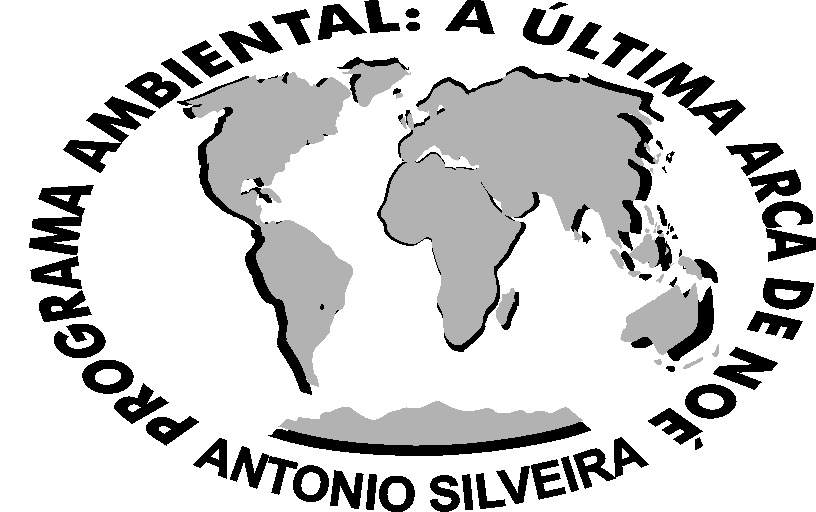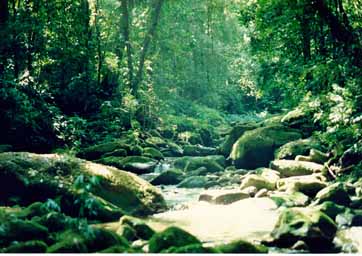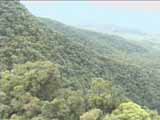
BRAZIL'S ECOSYSTEMS

BRAZIL'S ECOSYSTEMS
Atlantic Forest (Mata Atlântica)
(The splendid Atlantic Wood)


Definition
The vegetal group that compounds the Atlantic Wood is too complex. It is placed in the Brazilian coastal region, from Rio Grande do Norte to Santa Catarina in the border with Rio Grande do Sul.
The Atlantic Wood is constituted in the following formations:
Atlantic Wood located in the slopes of Serra do Mar and in a lot of islands in São Paulo, Rio de Janeiro and mainly Paraná's coast;
Interiror Wood at the Brazilian tableland and Paraná River banks;
Araucaria Wood stands out araucárias (Araucaria angustifolia) occurring in Rio Grande do Sul, Santa Catarina and in isolated points of São Paulo State.
The trees generally reach 20 or 30 high meters and as there is a scalonated distribution, are not continuous as at the Amazonian Rainforest.
The high factor is predominant in the characterization of forestall formations that compound Atlantic Wood.
The Atlantic Wood is also formed by a lot of smallest associated ecosystems.
In the humid slopes forest is exuberant, because the humidity that comes from the rock wall that hold winds and the sea humidity favorable na impressive scenic beauty with vegetation covered by fog, originating the name of rainforest to this delighted world.
Over the wood limits, there is in the Southeast region a floristic constitution, the high camps of a basically herbaceous constitution, with some brushes. Because of the altitudes, winds blow, bringing much rain. The plants that live in these places have special characteristics because are subdue to extreme adverse conditions. There is a lot of endemism the high camps.
Because of its beauty and fauna and flora riches, the Atlantic Wood was declared as World Heritage by UNESCO.Biodiversity
The forested area of Atlantic Wood is one of the places of biggest biodiversity in the world. Besides, it is considered a biodiversity hotspot, classified by the Conservation International (CI).
Flora:
The Atlantic Wood flora has a big diversity, with around 20 thousand plant species, from which 8 thousand are endemic.
Some examples from this rich vegetation: Andira frachinifolia; Annona cacans; Araucaria angustifolia; Rheedia gardneriana; Tillandsia usneoides; Machaerium nictitans; Asstrocaryum aculeatissimun; Myrocarpus frondosus; Guarea macrophylla; Marlierea edulis; Paivaea langsdorffii; Costus spiralis; Nectandra megapotamica; Cabralea canjerana; Persea alba; Jacarandá semiserrata; Jacarandá heptaphyla; Jacaranda puberula; Metrodorea nigra; Drynis brasiliensis; Tabebuia cassinoides; Cecropia glazioui; Syagrus romanzoffiana; Eugenia brasiliensis; Campomanesia xanthocarpa; Calophyllum brasiliensis; Schizolobium parahyba; Aspidosperma parvifolium; Gaylussaca brasiliensis; Heliconia velloziana; Ocotea porosa; Attalea dubia; Inga sessilis;Tabebuia umbellata; Tabebuia alba; Tabebuia avellanedae; Tabebuia umbrellata; Myrciaria truncifolia; Dalbergia nigra; Hymenaea courbaril; Lecythis lanceolata; Syagrus romansoffianum; Tibouchina pulchra; Brunfelsia brasiliensis; Bysonima sericea; Cryptocaria moschata; Osmosia arbórea; Euterpes edulis; Caesalpinia echinata; Paretecoma peroba; Cyathea schanschin; Tibouchina granulosa; Sloanea monosperma; Bowdichia virgilioides; Lecythis pisonis; Erythrina verna;Bactris setosa; Virola oleifera and Quesnelia humilis; Vriesia altodaserrae; Vriesia ensiformes.
Fauna:
Fauna is also too rich. Among birds, mammals, reptiles and amphibians of the Atlantic Wood there are 1361 species, from which 567 are endemic.
From the 202 Brazilian species that are threatened of extinction, 171 are from the Atlantic Wood. Among mammals there are: Panthera onca; Felis concolor; Felis yagouaroundi; Felis pardalis; Procyon cancrivorus; Cerdocyon thous; Hydrochaeris hidrochaeris; Dayprocta azarae; Alouatta fusca; Brachyteles aracnóides; Tapirus terrestris; Leontopithecus etc.
In relation to the birds, there are about 600 species in the Atlantic Wood, variating from place to place, but almost also in bigger numbers than 200 species.
Among the hundreds of birds, we can quote, by its rarity Tinamus solitarius, Penelope jacutinga, Mitu mitu, Amazona brasiliensi, Procnias nudicollis, Carponis melanocephalus, Tangara-peruviana; Sporophila frontalis etc.
There are also a lot of amphibian species (frogs) and reptiles, besides insects and fishes.Legislation
- Art.225,§4º, Brazilian Federal Constitution: considers Atlantic Forest (Atlantic Wood) as national patrimony.
- Decree 750/93, about Atlantic Wood regeneration.Threatens to Atlantic Wood
Among the threatens to Atlantic Wood, we can quote:
Demographic explosion in its region;
Wood predatory exploration;
Illegal palm trees extraction (Euterpes edulis);
Real state speculation;
The lack of environmental concrete public politics;
The lack of supervision of Conservation Units;
The lack of population's environmental conscious
Forests multiple use
Which is the environmental importance of forests? Which are their utility and ways of use? And also what can be questioned about the subject are what we are going to talk about.
In biological and environmental terms it is known that forests provide mainly the maintenance of life's conditions for million ways of vegetal and animal life; maintenance of necessary humidity for the existence of propitious weather to life and quality of hydrical resources. It makes them really important in the environmental global system and consequently benefits human environment.
However, up little time ago were considered "development obstacles", so that were destructed with no criteria and there were not propitious environment for contrary voices. Now, because of these recent proves of its biological and environmental functions, added from the big necessity of food demand, it is indispensable its economical exploration, providing resistance o its destroy. The entire forest started representing more riches instead of destroying for starting any other activity. So, for its importance and rich diversity, plus technological development that has allowed the discovery of new natural fonts, forests can and must be profited.
Moreover, forestall resoucers exploration has been shown excellent each time more. From the exploration of its big vegetal diversity has been possible the development of local development processes, fixing and giving opportunities to its needy communities.. From its biodiversities has been emerging important pharmacological discovers to humanity, which must have the exploration ruled. From its native population we have been having some information directly related to these new discovers. From its fishing resources depends on million people surviving. We can also observe that from the rational use of scenic beauty of a lot of its places will be the world ecotourism future, employing million people, generating rich economy. It shows the multiple use they can and must have.
But, if we do not preserve virgin big extensions of our forest, as Conservation Units, it will be impossible the maintenance of our rich heritage for the future generations and the forest's future is totally endangered.Information
- In the Neotropical Region that consists of the American continent, there is 57% of tropical and equatorial forests of the planet, being calculated that 37% of reptiles, 47% of amphibians, 27% of mammals, 43% of birds and 34% of all the plants occur in this region (Project "Parques e Reservas, do Ministério do Meio Ambiente dos Recursos Hídricos e da Amazônia Legal para o PP-G7". vol.1).
- In its world biodiversity map, the Conservation International points Brazil as the planet of biggest biodiversity in the world.
- In the forests of high Amazonian Forest live the smallest primate of the world: Cebuella pygmaea.
All Rights Reserved